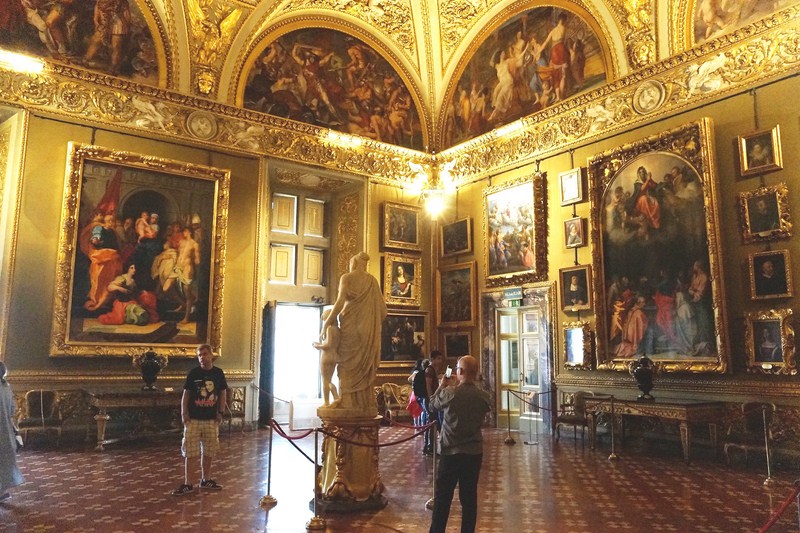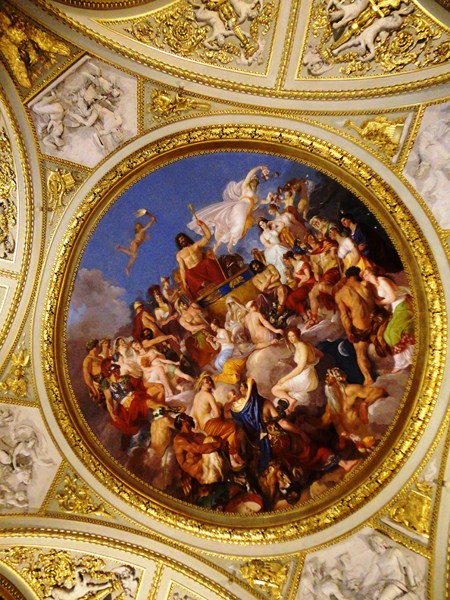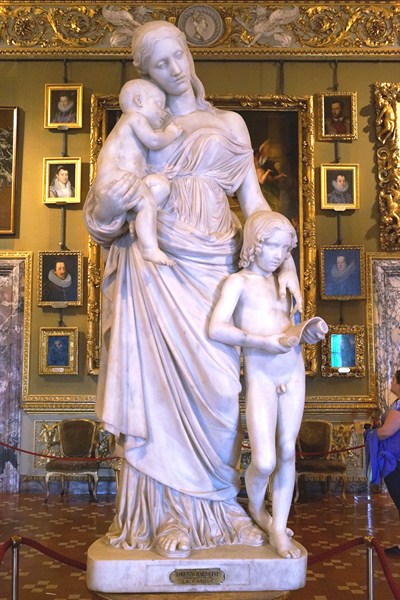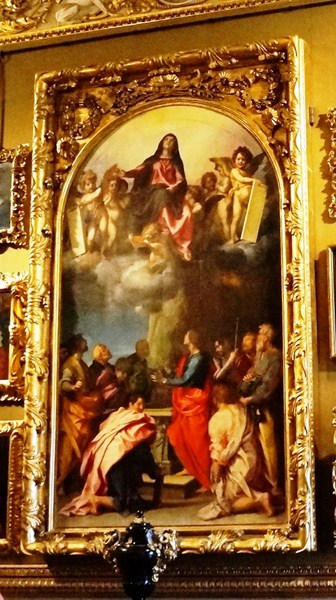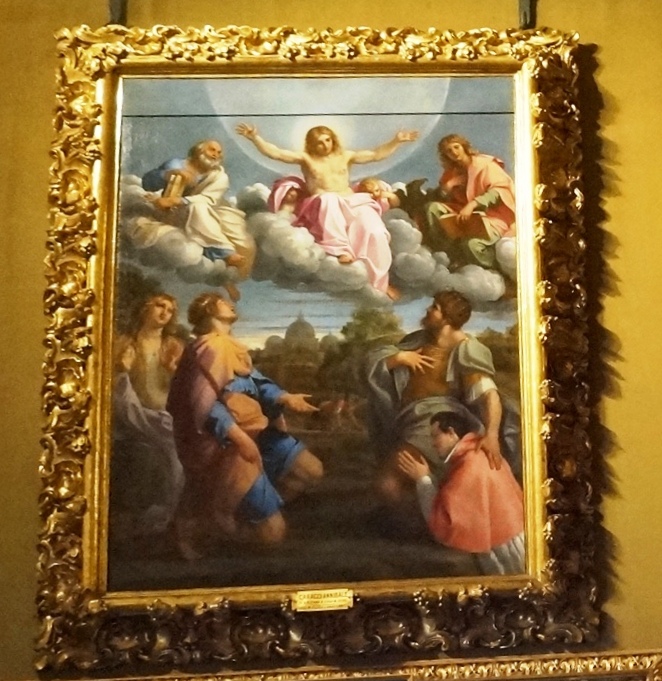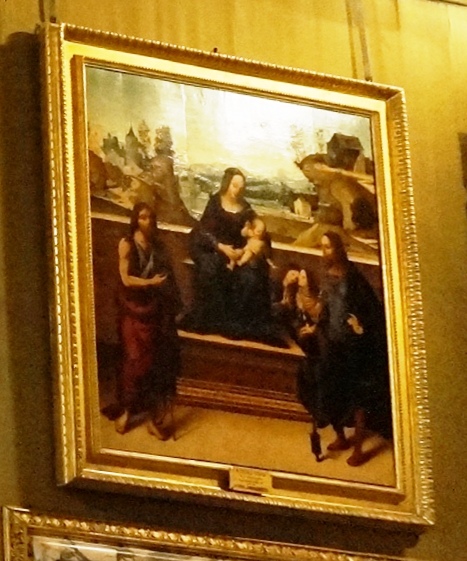During the Medici era, trucco (“trick, a form of ground billiards) was played here and, in 1689, Cosimo III de Medici made it his own private room, equipped with a chapel. The original decoration, by Giuseppe Nicola Nasini, dates back to that period with the Novissimi, four very large religious canvases that represented the last four moments of life – Death, Justice, the Inferno and Paradise.
In 1795, the Grand Duke Ferdinand III of Tuscany, of the House of Habsburg-Lorraine, had the religious canvases removed and incorporated the room in the sequence that would constitute a major part into the path of the Palatine Gallery.
He wanted to have it redecorated with a mythological theme but this program was only realized in 1815, after his return from Napoleonic exile, when he entrusted the enterprise to Luigi Sabatelli who, from 1819 to 1825, worked on it with the use of aid.
The fresco is a representation of the events prior to the Trojan War (taken from Book XV of Homer’s Iliad). At the center is the Council of the Gods where Jove (Jupiter) orders the assembled gods to refrain from interfering or trying to influence the outcome of the Trojan War.

Lunettes depicting Juno, who despised the Trojans, using various initiatives to distract Jove with her seductions.
The lunettes, on the other hand, depict Juno, who despised the Trojans, using various initiatives to distract Jove with her seductions.
On display is La Gravida (ca. 1506), a work by Raphael, whose brilliant colors are enhanced by the black background, typical of contemporary Flemish painting.
Each wall has a large altarpiece in the center which, as a whole, exemplifies the various currents of the early sixteenth century in Florence.
Two, in rigorous symmetry, are by Andrea del Sarto – the Assunta Passerini (1526) and the Assunta Panciatichi (ca. 1522-1523). Another, the Pala Pitti (1512), is by Fra Bartolomeo, while the Pala Dei (1522) is by Rosso Fiorentino.
Other works in the Hall of the Iliad include:
- Parable of the Sower of Darnel (Workshop of Jacopo Bassano)
- Battle of Montemurlo (Battista Franco, ca. 1537)
- Ascent to Calvary (Frans Francken II)
- Christ in Glory and Saints (Annibale Carracci, ca. 1597-1598)
- Portrait of Henrietta Maria of France (Frans Pourbus the Younger, ca. 1612)
- Portrait of Eleonora Gonzaga (Frans Pourbus the Younger, ca. 1603)
- Male Portrait (Jan Cornelisz Vermeyen, ca. 1530)
- Portrait of Christina of France (Frans Pourbus the Younger, ca. 1612)
- Male Portrait as a Warrior Saint (16th Century Northern Italian School)
- Portrait of Domenico Cresti known as il Passignano (Justus Suttermans, ca. 1635)
- Female Portrait (Ridolfo del Ghirlandaio, 1509)
- Madonna and Child Enthroned, Saint John the Baptist and Saint Eustace (Niccolò Soggi, ca. 1510)
- Saint John the Evangelist (Carlo Dolci, 1671)
- Portrait of Onofrio Bartolini Salimbeni (Girolamo da Carpi, ca. 1524)
- Portrait of Mattias de ‘Medici (Justus Suttermans, ca. 1660)
- Portrait of Paul III (copy from Titian, 16th century)
- Male Portrait (Titian, ca. 1540-1550)
- Copy of the Madonna of San Girolamo by Correggio (attributed to Federico Barocci)
- Portrait of a Woman (Scipione Pulzone, ca. 1595)
- Female Portrait (Scipione Pulzone, ca. 1570)
- Portrait of Emperor Ferdinand II (Justus Suttermans, 1623)
- Moses (Carlo Dolci, ca. 1645)
- Portrait of Francesco I de ‘Medici (Cristofano dell’Altissimo, ca. 1562)
- Female Portrait (Scipione Pulzone, ca. 1595)
- Portrait of Eleonora Gonzaga (Justus Suttermans, 1623)
- Goldsmith (Ridolfo del Ghirlandaio, ca. 1515-1517)
- Archangel Raphael Refusing Tobias’s Gifts (Giovanni Bilivert, 1612)
- Conversion of the Magdalene (Artemisia Gentileschi, 1615-1616)
- Portrait of Philip II of Spain (Titian and workshop, ca. 1550)
- Christ in the House of Martha and Mary (Workshop of Jacopo and Francesco Bassano)
- Portrait of Leopoldo de ‘Medici (Justus Suttermans, ca. 1660)
- Giuditta with her handmaid (Artemisia Gentileschi, 1618-1619)
- Saint Benedict and Saints (Paolo Veronese and workshop, 1572)
- Male Portrait (attributed to Venetian school)
- Portrait of Maria de ‘Medici (attributed to Frans Pourbus the Younger, ca. 1610)
- Madonna and Child (Andrea del Sarto, 1528-1530)
- Portrait of Scipione Nerchi Mutolo (Emilian school of the seventeenth century)
- Portrait of Eleonora de ‘Medici (Frans Pourbus the Younger, ca. 1600-1609)
- Portrait of Valdemaro Cristiano (Justus Suttermans, 1638-1639)
- Baptism of Christ (Paolo Veronese, ca. 1580)
- Prayer in the Garden (Francesco Bassano, ca. 1580-1590)
- Portrait of Ferdinand II de ‘Medici (Justus Suttermans, ca. 1635)
- Equestrian Portrait of Philip IV of Spain (attributed Diego Velázquez)
- Tarquinio and Lucrezia ( Simone Pignoni)
- Equestrian Portrait of the Elector Palatine (Jan Frans van Douven, 1707)
- Portrait of Queen Elizabeth of England (School of Marcus Gheeraerts the Younger, ca. 1592-1603)
- Tarquinio and Lucrezia (attributed to Onorio Marinari)
- Bacchus and Ariadne (copy from Titian)
- Saint Mary Magdalene (Domenichino, ca. 1620-1630)
- Presentation of Jesus in the Temple (Paolo Veronese)
- Ruggero and Alcina (Rutilio Manetti)
- Charity (Lorenzo Bartolini, ca. 1817-1835)
- Four vases with handles formed by a swan with a putto (Massimiliano Soldani Benzi, 1689-1693)
- Two Tables (Florentine manufacture of the beginning of the century. XIX)
- Table (Lorenzo Dolci, 1788)
- Table (Florentine manufacture of the century XVIII, 1785)
Hall of the Iliad:First Floor, Palatine Gallery, Pitti Palace, Piazza de’ Pitti, 1, Florence, Italy. Tel:+39 055 294883. Open Tuesdays-Sundays, 8:15 AM – 6:50 PM. Admission: Palatine Gallery (€8.50), Silver Museum (€6.00), Gallery of Modern Art (€8.50), Costume Gallery/Porcelain Museum/Boboli Gardens/Bardini Garden (€6.00).
How to Get There: Take the C3 or D bus to the Pitti stop.

